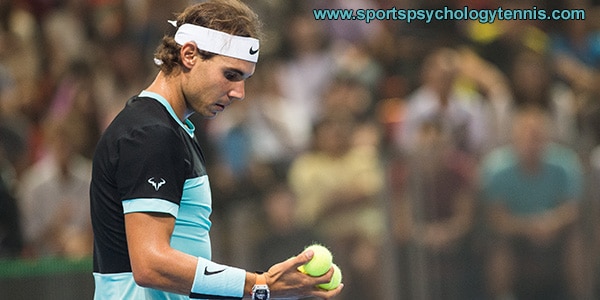
Do Nadal’s Superstitions Help Him Perform?
How do superstitions, rituals, and routines affect your performance in tennis matches? And what is the difference between them?
Many tennis players, like other athletes, are superstitious and believe superstitions affect how they perform on the court. And tennis players adopt many different superstitions…
One players I worked with HAD TO take a shower before each match or between rounds, for example.
I’ve also worked with tennis players that had to eat a certain mean before matches, wear lucky shoes, or do the same activity before arriving to the court for warm up.
But keep in mind that superstitions and routines are two different concepts altogether.
An examination of superstitions, rituals, and routines will be helpful for you to understand how to improve performance in matches.
Superstitions in Tennis
A superstition is an irrational belief that a repeated behavior will have a profound impact on the outcome of a match. One commonly-held superstition is that carrying a rabbit’s foot brings about good luck.
In tennis, players cling to unique superstitions without questioning their validity and rarely deviate from these behaviors–even if they fail to work our for them.
Some of these superstitions include: carrying a lucky object (lucky penny, a particular tennis ball), wearing the same article of clothing (a favorite tee-shirt during warm-up, the same pair of socks), the avoidance of objects (not stepping on sidelines or touching the net during warm-up) or the placement of their equipment (putting their equipment bag in a certain location behind the bench) just to mention a few…
The implication of superstitions is, if you adhere to a previous behavior that you had success with in the past, it will bring you good luck and help you play your best tennis in the upcoming match.
Unfortunately, the unspoken reverse is also true. If you forget a lucky object or something interferes with your ability to carry out your superstitions, your game will suffer to some degree or you will be doomed. This certainly doesn’t help you.
Superstitions are problematic for several reasons. For starters, superstitions are not based on fact but luck. That is, superstitions have absolutely zero scientific proof. If you win while you were wearing you lucky socks, the socks were not the reason you won; it was merely coincidental. Sorry to break the bad news
Second, if you were, for some reason, unable to follow that superstition (perhaps you forgot to pack your lucky socks), you will feel less comfortable and have difficulty focusing on what truly helps you play your best tennis.
Third, superstitions are more about generalizations you have made from the past, such as “I won an important match eating rice before the match.” The false assumption is that eating rice will help you win because it helped in the past.
Finally, superstitions are a crutch and provide a false sense of confidence.
Instead of crediting yourself for your successes, you attribute your success to luck.
Rituals in Tennis
Rituals and routines are terms that are sometimes used interchangeably but there is a distinction.
Rituals are focused around a group of people, such as a team and their staff, fans or student bodies. Some examples of rituals are pep rallies, team breakfasts, preseason team building exercises, locker room traditions or a cheer during team warm-ups.
These activities may be consistent rituals but are ceremonial in nature and have little effect on performance.
Routines in Tennis
Routines are a sequence of actions performed prior to a particular task, such as a warm up routine or a pre-service routine.
Consider your routine similar to a Standard Operating Procedure. A standard operating procedure is a thought out series of action steps that lead up to performing a task. In that sense, routines are consistent and performed the same way every time.
In sports, routines can include what you do before a match, what you do in warm-up, what you do prior to every serve and what you do after each point. Routines are meant to prepare you for what is ahead. In essence, the completion of a routine signals your mind and body that you are ready to perform.
There are scientific studies that provide evidence to support the benefits of routines:
* When you are prepared, you feel more confident.
* When you are focused on a routine before each point, you are less aware of distractions.
* When you perform a routine, you are, in effect, letting go of what has happened in the past, such as mistakes and unforced errors.
* When you focus on a pre-service routine, you lessen the anxiety that is generated by thinking about potential future outcomes.
The Superstitions and Routines of Rafael Nadal
Rafael Nadal is well-known for his many behaviors, both superstitious and routine. Within the last six months, Nadal had two incidences where he appeared frustrated and angry after his preferred placement of his water bottles was disrupted.
NADAL: “I put my two bottles down at my feet, in front of my chair to my left, one neatly behind the other, diagonally aimed at the court. Some call it superstition, but it’s not. If it were superstition, why would I keep doing the same thing over and over whether I win or lose? It’s a way of placing myself in a match, ordering my surroundings to match the order I seek in my head.”
Some of Nadal’s other superstitions include:
* He wears both socks at the same height.
* He always places his bottles in the same exact position.
* He ensures his opponent crosses the net before he does during a changeover.
* He avoids walking on the sidelines.
None of these actions have a particular bearing on how Nadal performs but, nonetheless, he continues to perform these faithfully every match.
Other behaviors that Nadal performs are more consistent with routines or things that mental and physically prepare him for action. For instance, Nadal takes a freezing cold shower 45 minutes prior to all of his matches.
NADAL: “Freezing cold water. I do this before every match. It’s the point before the point of no return. Under the cold shower, I enter a new space in which I feel my power and resilience grow. I’m a different man when I emerge. I’m activated. I’m in ‘the flow’, as sports psychologists describe a state of alert concentration in which the body moves by pure instinct… Nothing else exists but the battle ahead.”
Other actions by Nadal that can be considered routines are:
* He places his hair behind his ear and fiddles with his shorts or underwear before each serve.
* He uses a towel after every single point. Until the shot clock came into existence, which now alters his routine.
* He doesn’t put his headband on until just before he enters the court.
Each of these actions helps narrow Nadal’s focus and becomes an unconscious and, at times, a conscious signal that he is ready to go.
The difference between routines and superstitions depend upon the reasoning behind the behavior. Is it based on luck or generalization?
A routine is a planned series of actions in a particular sequence that is designed to help you perform on a consistent basis. They help to:
* Release the last point
* Relax your mind and body
* Ready yourself for the next moment
My suggestion is to develop sound preparatory routines, instead of relying on lucky superstitions. Ask yourself:
Is this behavior based on fact or on just luck? Does it really help me perform? Does it give me confidence?
My tip for today is to work on developing a prematch routine and pre-point routines that help you perform your best on the court. Prematch routines, unlike superstitions, are based on science and sound mental preparation strategies.
A prematch routine should help you improve confidence, focus, and trust in your skills before you start. Routines also help you prepare mentally for the match as you visualize your performance or game plan.
Please comment and post your superstitions that you MUST do prior to a match because you think it works…
Related Tennis Psychology Articles:
- Do Tennis Players Benefit From Superstitions Or Routines?
- How Nadal Uses Preparation to Develop His Mental Strength
- How Fernandez Focuses in Matches
- Download our a FREE Tennis Psychology Report
*Subscribe to The Tennis Psychology Podcast on iTunes
*Subscribe to The Tennis Psychology Podcast on Spotify
Improve Your Mental Game for Tennis
Tennis Confidence 2.0

“Tennis Confidence: Mental Game Strategies for Tournament Players” is Dr. Cohn’s program to help tennis players, coaches, and instructors improve the mental game of tennis is just 8 easy to learn sessions. Tennis Confidence: Mental Game Strategies for Tournament Players Audio and Workbook program is ideal for any junior, collegiate, and tour professional player. Tennis coaches and instructors would also be wise to teach the strategies in “Tennis Confidence 2.0.”
Tennis Confidence is a complete mental training program developed Dr. Cohn. You learn the same strategies Dr. Cohn teaches his personal students to help them improve mental toughness and consistency – from managing unrealistic expectations to coping with perfectionism.
Read more about Tennis Confidence Program>>
Thank you for this interesting article. I don’t think what Nadal does is superstition (bottles, etc..). He does not do that because he thinks it’ll help him win. He knows he can lose anytime He does that because he’s anxious by nature and he feels secure when he’s in his habits. The bottles aligned are just like having his team with him during the match. It’s about a feeling of security and finally confidence. Different from a superstition. It definitely helps him in my opinion, even it’s heavy to do all those things.
Thank you for redirecting readers’ attention about these superstitions toward what they actually are: routines. Full agreement that routines help avoid confusion or distraction, and thus enable more focus. Batting champion Wade Boggs used to be poked about his superstitious eating the same meal before games. He confided to a few of us in a personal conversation that all of his antics were intended to enable him to focus all of his pre-game thinking on the opposing pitchers and his most recent hitting techniques.
An individual’s sensitivities can also be served by such routines. Some athletes have spectrum-type aversions, such as tactile sensitivity, which when mitigated by showers or cutting off labels or wearing a shirt with a specific feel, can help their playing comfort enormously.
I used to be annoyed by Nadal’s routines but the more I have played tennis, the more I understand that having a consistent procedure to follow before each point, allows you to prepare consistently for each point and likely allows you to be a better, less distracted player.
For sure one thing that annoys me now is when players deliberately serve before I am ready – and I do not take a long time over setting myself. To be fair you should play at the servers pace and not hold up his/her routine – something that Kyrgios does not like about serving to Rafa. But some players will deliberately try to serve before you can compose yourself to gain an advantage – Andre Agasis actually recommends mixing up your serving routine so that the receiver cannot settle so easily into a comfortable receiving routine. I think that is a bit dangerous as you can put yourself off!